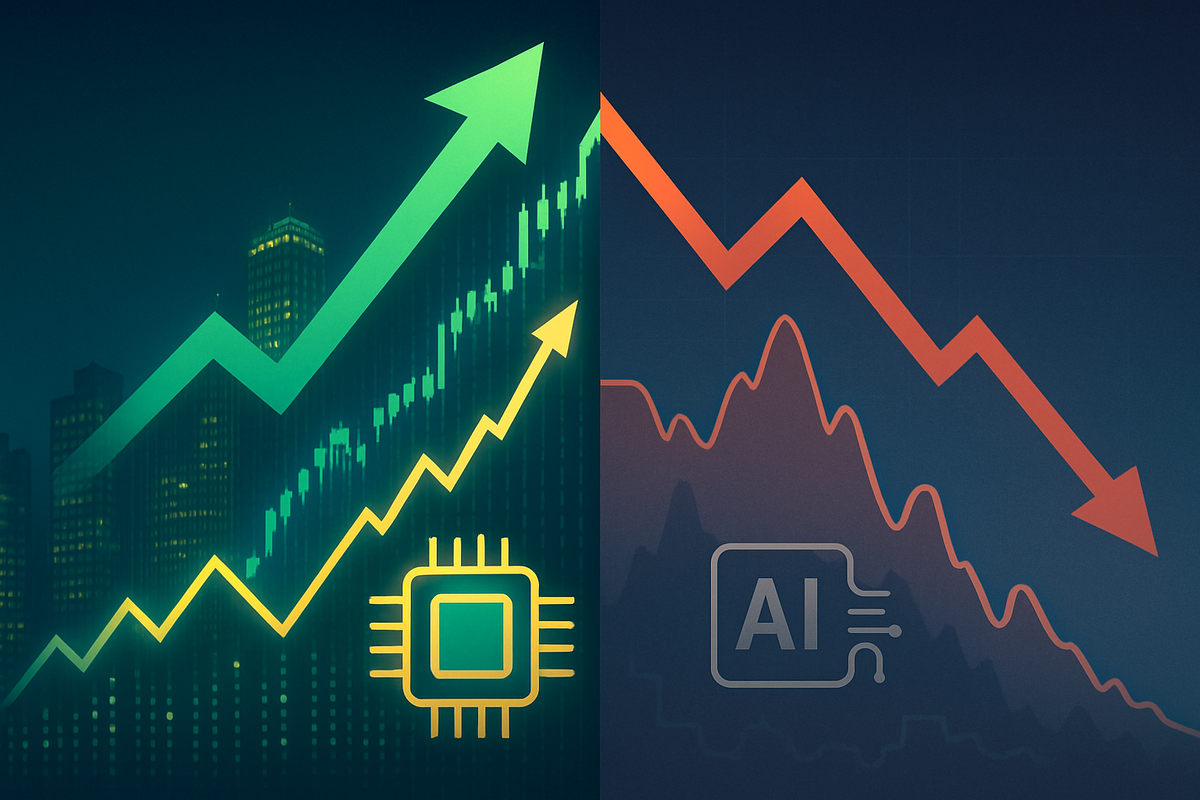
The financial markets on October 2nd and 3rd, 2025, presented a fascinating dichotomy, showcasing both robust optimism and underlying caution. While the Dow Jones Industrial Average staged a notable recovery to hit an all-time high and AI behemoth Nvidia (NASDAQ: NVDA) continued its relentless ascent, reaching new record valuations, a broader swath of AI-related stocks experienced a nuanced sell-off. This divergence highlights a market grappling with fervent enthusiasm for artificial intelligence's transformative potential, alongside increasing scrutiny over sustainability and valuation in the rapidly expanding sector.
This period saw investors making clear distinctions, pouring capital into established AI leaders with proven revenue streams and critical infrastructure, while simultaneously pulling back from other AI players, suggesting a selective approach to the AI-driven rally. The market's ability to largely shrug off an ongoing U.S. government shutdown, initially impacting cyclical sectors, further underscored the compelling narrative surrounding AI's immediate impact on investor sentiment.
A Tale of Two Markets: Dow's Resilience Amidst AI's Selective Surge
The early days of October 2025 painted a complex picture for the stock market. On October 2nd, the Dow Jones Industrial Average initially slipped by 96 points (0.2%), primarily due to underperformance in financial and industrial sectors, which felt the immediate "political drag" of an ongoing U.S. government shutdown. However, the market quickly recalibrated. By October 3rd, the Dow had not only recovered but surged, climbing 366 points (0.8%) to reach an all-time high, alongside the S&P 500 and Nasdaq Composite, demonstrating the broader market's underlying resilience and the pervasive influence of tech-driven optimism.
At the epicenter of this optimism was Nvidia (NASDAQ: NVDA), the undisputed leader in AI chips and data center hardware. The company's stock continued its meteoric rise, jumping above $191 on October 2nd, marking a new all-time high and extending its year-to-date gains beyond 41%. This incredible surge was fueled by a confluence of significant developments, including news of a colossal $100 billion investment in OpenAI's infrastructure, a strategic $5 billion chip collaboration with Intel (NASDAQ: INTC), and proactive efforts to bolster the U.K. AI startup ecosystem. Nvidia's sustained rally on October 3rd, trading near its intraday highs above $190, solidified its position as a primary beneficiary of the AI revolution, with investors piling in on the expectation of expanding AI chip demand.
However, the AI rally was far from uniform. While Nvidia and a select few others soared, a "subtle undercurrent of caution" led to profit-taking and a "nuanced sell-off" in a broader range of AI-related stocks. This selective retreat was evident in companies like Applied Materials (NASDAQ: AMAT), a semiconductor equipment giant, which saw its shares drop 3% after announcing that U.S. export restrictions could significantly cut its Q4 revenue. This incident highlighted how specific regulatory hurdles or supply chain vulnerabilities could disproportionately impact individual players within the vast AI ecosystem, even as the overall AI narrative remained robust. Concerns around "vendor financing" or "circular financing" in large AI deals also contributed to this profit-taking, suggesting investors are becoming more discerning about the financial underpinnings of AI growth.
Winners and Losers: The Bifurcated Impact of the AI Boom
The recent market movements clearly delineated the current winners and those facing headwinds in the burgeoning AI landscape. At the forefront of the winners' circle are the foundational technology providers crucial to AI development and deployment. Nvidia (NASDAQ: NVDA) stands as the preeminent victor, with its specialized GPUs forming the backbone of most advanced AI systems. Its recent surge, propelled by massive data center investments and strategic partnerships, underscores its irreplaceable role. Similarly, other semiconductor giants like Advanced Micro Devices (NASDAQ: AMD) and Broadcom (NASDAQ: AVGO) also experienced significant gains, with AMD surging over 3% and Broadcom advancing 2% on October 3rd. These companies are capitalizing on the relentless demand for high-performance computing necessary to train and run complex AI models. Their robust performance reflects investor confidence in their ability to deliver critical hardware components for the AI revolution, positioning them as long-term beneficiaries.
Conversely, the "sell-off in other AI-related stocks" indicates a growing caution among investors regarding the broader, perhaps less differentiated, segments of the AI market. Companies that are perceived to have less direct or less established roles in the core AI infrastructure, or those facing specific operational challenges, found themselves under pressure. The example of Applied Materials (NASDAQ: AMAT), impacted by U.S. export restrictions, illustrates how geopolitical factors and supply chain dependencies can quickly turn investor sentiment negative, even within a booming sector. This suggests that while the AI tide is rising, it is not lifting all boats equally. Investors are increasingly scrutinizing business models, competitive advantages, and the tangible financial returns of AI investments beyond the immediate hype.
This divergence also points to a maturation in investor behavior within the AI space. Early in the AI boom, nearly any company with an "AI" tag might have seen its stock rise. Now, however, there's a clear flight to quality, with capital concentrating in firms that demonstrate strong market leadership, robust financials, and clear pathways to monetizing AI innovation. This shift implies that companies relying on speculative growth or lacking a distinct competitive edge in the AI arena may struggle to maintain their valuations, potentially facing further corrections as the market demands more concrete results and sustainable business models.
Wider Significance: AI's Broader Economic and Historical Context
The current market dynamics, characterized by a surging Dow and AI leaders alongside selective profit-taking, carry significant wider implications. This event fits squarely into the broader industry trend of artificial intelligence becoming the dominant technological and investment theme of the decade. The fervent investor confidence, described as a "relentless bid for artificial intelligence leaders," suggests a belief that AI's transformative potential is still in its early stages, capable of driving unprecedented economic growth and corporate profitability. This enthusiasm has been so potent that it effectively "offset the market impact of a U.S. government shutdown," underscoring AI's perceived insulation from traditional economic headwinds.
However, this exuberance also ignites concerns about the sustainability of the AI-driven rally, drawing historical parallels that resonate with market veterans. Goldman Sachs CEO David Solomon's warning of a potential "drawdown" in equity markets over the next 12 to 24 months, with comparisons to the late 1990s internet boom, highlights a critical debate: Is this a genuine, fundamental shift, or are elements of an AI bubble forming? The selective sell-off in some AI-related stocks suggests that a segment of the market is already exercising caution, distinguishing between established, revenue-generating AI powerhouses and newer, potentially overvalued entrants. This discerning approach could prevent a widespread crash but indicates a period of increased volatility and valuation adjustments for specific companies.
The ripple effects extend beyond the immediate tech sector. The massive investments in AI infrastructure, exemplified by the $100 billion commitment to OpenAI, signal a fundamental reshaping of data centers, cloud computing, and enterprise software. This will inevitably impact competitors, partners, and even industries far removed from direct AI development, as companies across the spectrum seek to integrate AI into their operations. While direct regulatory or policy implications specific to these two days are not immediately apparent, the sheer scale of AI's economic impact will undoubtedly bring increased scrutiny from governments regarding competition, data privacy, and ethical AI development in the coming months and years. The ongoing U.S. government shutdown, though temporarily overshadowed by AI, serves as a reminder that macroeconomic and political factors can still exert significant influence, particularly on more cyclical sectors.
What Comes Next: Navigating the AI-Driven Market Landscape
Looking ahead, the market is poised for a dynamic period, with both immense opportunities and significant challenges emerging from the current AI-driven environment. In the short term, we can anticipate continued volatility, particularly within the broader AI sector. The selective nature of recent profit-taking suggests that investors will maintain a critical eye on valuations, demanding clear pathways to profitability and sustainable competitive advantages from AI-focused companies. We might see further consolidation as smaller, less differentiated AI players struggle to compete with the scale and resources of giants like Nvidia. The resolution of the U.S. government shutdown will also be a key short-term factor, potentially influencing the performance of cyclical stocks and overall market sentiment, though AI's momentum may continue to provide a buffer.
In the long term, the trajectory points towards sustained, albeit more scrutinized, investment in core AI infrastructure and applications. Companies that can demonstrate genuine innovation, strong intellectual property, and efficient monetization strategies for their AI offerings are likely to thrive. This could lead to strategic pivots for many organizations, as they adapt their business models to leverage AI more effectively or to counter disruption from AI-native competitors. Market opportunities will emerge in areas such as specialized AI hardware, AI-powered software solutions for various industries, and services that facilitate AI adoption. However, challenges will include managing the immense capital expenditure required for AI development, navigating evolving regulatory landscapes, and addressing ethical considerations related to AI deployment.
Potential scenarios range from a continued "soft landing" for the broader market, where AI's growth helps offset other economic pressures, to a more pronounced "AI bubble burst" for overvalued companies, should investor sentiment shift dramatically or if anticipated returns fail to materialize. A more likely outcome is a bifurcated market where dominant AI players continue to command premium valuations, while the rest of the sector undergoes a necessary period of correction and rationalization. Investors should closely monitor corporate earnings reports for tangible evidence of AI's impact on profitability, watch for further government actions on technology regulation, and observe global economic indicators for signs of broader market health.
Comprehensive Wrap-up: A Market in Transition
The events of October 2nd and 3rd, 2025, serve as a potent summary of the current financial market's complex state. The key takeaway is a market in transition, profoundly shaped by the artificial intelligence revolution but also exhibiting a discerning, at times cautious, approach to its vast potential. While the Dow Jones Industrial Average's recovery to all-time highs and Nvidia's (NASDAQ: NVDA) continued dominance underscore the resilience of the broader market and the concentrated power of leading tech innovators, the simultaneous sell-off in other AI-related stocks signals a critical shift in investor sentiment. This shift moves beyond mere hype towards a demand for tangible value, sustainable business models, and clear competitive advantages within the AI ecosystem.
Moving forward, the market will likely be characterized by this ongoing bifurcation. Leading AI companies, particularly those providing foundational hardware and essential software, are well-positioned to continue attracting significant capital. However, the broader AI landscape will face increased scrutiny, with investors becoming more selective and less tolerant of speculative valuations. The ability of companies to translate AI innovation into measurable financial performance will be paramount. The market's resilience in the face of an ongoing government shutdown also highlights the powerful, almost insulating, effect of a compelling technological narrative, though such resilience may not be limitless.
Investors should watch for several critical factors in the coming months. These include the resolution of macroeconomic uncertainties, particularly the government shutdown and any shifts in interest rate policy. Crucially, attention will remain fixed on corporate earnings, especially from AI-centric companies, to assess the real-world impact and monetization of AI investments. Furthermore, any new regulatory frameworks pertaining to AI, both domestically and internationally, could significantly influence market dynamics. The long-term impact of AI remains undeniably profound, but the current market signals a maturation phase, where discernment and fundamental analysis will increasingly dictate investment success.
This content is intended for informational purposes only and is not financial advice.






